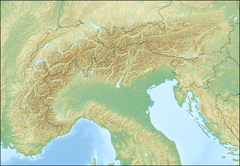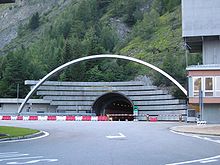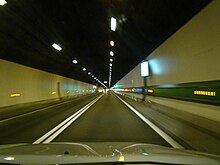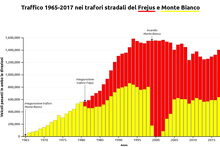 | |
| Overview | |
|---|---|
| Other name(s) | Tunnel du Mont-Blanc (French) Traforo del Monte Bianco (Italian) |
| Location |
|
| Coordinates | 45°51′14″N 6°54′50″E / 45.854°N 6.914°E / 45.854; 6.914 |
| Status | Open |
| Route | |
| Start | Chamonix, Haute-Savoie, France |
| End | Courmayeur, Aosta Valley, Italy |
| Operation | |
| Work begun | May 1959 (1946) |
| Constructed | 1959–65 |
| Opened | 19 July 1965 |
| Operator | MBT-EEIG, controlled by both ATMB and SITMB |
| Traffic | Automotive |
| Character | Passenger and freight |
| Toll | €48.- (one-way), 2020 passenger vehicle over €300 (one-way), three or more axles |
| Technical | |
| Length | 11.611 km (7.215 mi) |
| No. of lanes | 2 |
| Operating speed | 50–70 km/h (31–43 mph) |
| Highest elevation | 1,395 m (4,577 ft) center |
| Lowest elevation | 1,274 m (4,180 ft) France (NW) |
| Tunnel clearance | 4.35 m (14.3 ft) |
| Width | 8.6 m (28 ft) |



The Mont Blanc Tunnel (French: Tunnel du Mont-Blanc, Italian: Traforo del Monte Bianco) is a highway tunnel between France and Italy, under Mont Blanc in the Alps. It links Chamonix, Haute-Savoie, France with Courmayeur, Aosta Valley, Italy, via the French Route Nationale 205 and the Italian Traforo T1 (forming the European route E25), in particular the motorways serving Geneva (A40 of France) and Turin (A5 of Italy). The passageway is one of the major trans-Alpine transport routes, particularly for Italy, which relies on this tunnel for transporting as much as one-third of its freight to northern Europe. It reduces the route from France to Turin by 50 kilometres (30 miles) and to Milan by 100 km (60 mi). Northeast of Mont Blanc's summit, the tunnel is about 15 km (10 mi) southwest of the tripoint with Switzerland, near Mont Dolent.
The agreement between France and Italy on building a tunnel was signed in 1949. Two operating companies were founded, each responsible for one half of the tunnel: the French Autoroutes et tunnel du Mont-Blanc (ATMB), founded on 30 April 1958, and the Italian Società italiana per azioni per il Traforo del Monte Bianco (SITMB), founded on 1 September 1957. Drilling began in 1959 and was completed in 1962; the tunnel was opened to traffic on 19 July 1965.
The tunnel is 11.611 km (7.215 mi) in length, 8.6 m (28 ft) in width, and 4.35 m (14.3 ft) in height. The passageway is not horizontal, but in a slightly inverted "V", which assists ventilation. The tunnel consists of a single gallery with a two-lane dual direction road. At the time of its construction, it was twice as long as any existing highway tunnel.
The tunnel passes almost exactly under the summit of the Aiguille du Midi. At this spot, it lies 2,480 metres (8,140 ft) beneath the surface, making it the world's second deepest operational tunnel after the Gotthard Base Tunnel.
The Mont Blanc Tunnel was originally managed by the two building companies. Following a fire in 1999 in which 39 people died, which showed how lack of coordination could hamper the safety of the tunnel, all the operations are managed by a single entity: MBT-EEIG, controlled by both ATMB and SITMB together, through a 50–50 shares distribution.
An alternative route for road traffic between France to Italy is the Fréjus Road Tunnel. Road traffic grew steadily until 1994, even with the opening of the Fréjus tunnel. Since then, the combined traffic volume of the former has remained roughly constant.
Construction statistics
- Workforce: five engineers and 350 workmen worked an estimated grand total of 4.6 million man-hours to complete the project
- Explosives: 711 tonnes (700 long tons; 784 short tons) of explosives were used to blast 555,000 m (19,600,000 cu ft) of rock
- Energy: 37 million kilowatt-hours and 2,700,000 litres (590,000 imp gal; 710,000 US gal) of fuel for trucks and engines
- Other facts: 771,240 bolts, 6,900 drill rods, and 300 tonnes (300 long tons; 330 short tons) of iron were used to support the vault, 5,000 m (180,000 cu ft) of formwork for 60,000 tonnes (59,000 long tons; 66,000 short tons) of cement (mixed with 280,000 m (9,900,000 cu ft) of aggregates)
History

The idea of building a tunnel underneath Mont Blanc to avoid the need for long journeys dates back to the nineteenth century during the heyday of the railway. However, the idea did not receive widespread attention until 1907, when Francesco Farinet, a Member of Parliament of the Aosta Valley, advocated constructing of the tunnel. In 1908, a first design was presented by French engineer Arnold Monod, to much interest from Italian and French politicians.
Agreement between France and Italy and start of construction by 1959
Due to political turmoil and World War I and World War II, the project did not start until 1959, when excavations on the tunnel officially began. This was preceded by the signing of a national charter for the tunnel construction, ratified by the parliaments of France (1957) and Italy (1954). That same year, the STMB (Société du tunnel du Mont Blanc) was formed, which became ATMB (Autoroutes et Tunnel du Mont Blanc) in 1996. In 1962, the French and Italian drilling teams met on 4 August. The opening was successful, with an axis variation of less than 13 centimetres (5 inches).
Opening
The tunnel was inaugurated by the French president, Charles de Gaulle, and the Italian President, Giuseppe Saragat on 16 July 1965. The tunnel opened to traffic on 19 July. Surveillance cameras were installed in 1978.
Updates in the 1990s
The tunnel underwent extensive modernisation works in 1990, including the addition of safety features such as new video surveillance cameras, 8 pressurized emergency shelters, a sprinkler system and other safety maintenance. In 1997, a fire detection system was installed along with centralized safety equipment management, and new variable message signs.
1999 fire
Main article: Mont Blanc Tunnel fire
On the morning of 24 March 1999, the engine of a Belgian transport truck carrying volatile freight caught fire in the tunnel. The event expanded into a catastrophe which killed 39 people.
2002 reopening
The fire led to a tunnel closure until 9 March 2002. The reopening followed an extensive overhaul of the safety features. The highway trunk from Aosta to the tunnel on the Italian side was completed in 2007.
Traffic

In 2010, the average traffic volume was 4,945 vehicles per day, or around 1.80 million vehicles per year. In 2011, there were an average of 5,113 vehicles per day (about 1.87 million vehicles per year).
Although several lines of vehicles can queue up at the toll station, only a limited number of vehicles per unit time is allowed to transit the tunnel to ensure a safety distance between them.
Within the tunnel, a minimum speed of 50 km/h and a maximum speed of 70 km/h applies, while the prescribed distance between vehicles is 150 m; trucks are allowed to enter in groups of five. These security measures were taken as a consequence of the 1999 tunnel fire.
Pedestrians can cross the tunnel by bus; bicycles can also be carried through the tunnel with a reservation.
Toll

The tunnel crossing is subject to a toll; the toll differs from Italy to France because of their different VAT rates.
In 2013, the one-way ticket for a car was €40.90 (€41.40 on the Italian side), while the return ticket, valid for 7 days, was €51 (€51.60 on the Italian side). In 2016, the one-way ticket for a car cost €43.50 (€44.20 on the Italian side).
Mont Blanc Tunnel Tolls on the Italian side from 1 January 2022 (22% VAT included)
| Vehicle Type | One Way | Return |
|---|---|---|
| Cars | €52.30 | €65.30 |
| Motorbikes | €34.60 | €43.50 |
| Caravans | €69.30 | €87.10 |
Mont Blanc Tunnel Tolls on the French side from 1 January 2022 (20% VAT included)
| Vehicle Type | One Way | Return |
|---|---|---|
| Cars | €51.50 | €64.20 |
| Motorbikes | €34.10 | €42.80 |
| Caravans | €68.10 | €85.60 |
See also
References
- ^ Barry, Keith (15 July 2010). "July 16, 1965: Mont Blanc Tunnel Opens". Wired. Retrieved 16 July 2010.
- Soule, Gardner (December 1959). "World's longest auto tunnel to pierce the Alps". Popular Science. pp. 121–123/236–238.
- "Today in Science History". Retrieved 22 November 2014.
- "A French-Italian Operator - Autoroutes et Tunnel du Mont Blanc". Archived from the original on 29 July 2012. Retrieved 27 September 2011.
- ^ "Mont Blanc Tunnel at age 46". www.tunneltalk.com. Retrieved 21 December 2018.
- ^ Barry, Keith (16 July 2010). "July 16, 1965: Mont Blanc Tunnel Opens". Wired. ISSN 1059-1028. Retrieved 21 December 2018.
- "Histoire du Tunnel du Mont Blanc". ATMB (Autoroutes et Tunnel du Mont Blanc). Archived from the original on 21 December 2018. Retrieved 29 February 2024.
- "History of the Tunnel". Autoroutes et Tunnel du Mont Blanc. Archived from the original on 4 January 2014. Retrieved 20 December 2013.
- "The Fire of 1999 - Autoroutes et Tunnel du Mont Blanc". Archived from the original on 29 July 2012. Retrieved 27 September 2011.
- "Mont Blanc tunnel reopens". 9 March 2002. Retrieved 21 December 2018.
- "The security features of the Mont Blanc Tunnel | DW | 17 July 2015". DW.COM. Retrieved 21 December 2018.
- "A5 Mont Blanc-Aosta Motorway - Courmayeur- Morgex Section – Lot No 2 - Salini Impregilo". www.salini-impregilo.com. Retrieved 21 December 2018.
- "TMB - Tarifs". archive.wikiwix.com (in French). Archived from the original on 30 December 2013. Retrieved 12 November 2018.
- ^ "Mont Blanc Tunnel Toll Prices - Get from France to Italy". chamonix.net.
External links
- Official website
- "Traffic Tunnel to Pierce Mt Blanc." Popular Mechanics, April 1952, pp. 92–96. Detailed drawings of planned tunnel construction
- ATMB, Official Company Website (in English)
- ATMB, Official Company Website (in French)
- ATMB, Official Company Website (in Italian)
- Mont-Blanc Tunnel at Structurae
- Chamonix-Mont-Blanc Map
- BBC story on fire trial
| Records | ||
|---|---|---|
| Preceded byGreat St Bernard Tunnel 5.80 km (3.60 mi) |
World's longest road tunnel 1965–1978 |
Succeeded byArlberg Road Tunnel 13.98 km (8.69 mi) |
| Motorways in Italy | ||
|---|---|---|
| Roads in Italy | ||
| Major routes |  | |
| Beltways | ||
| Road tunnels | ||
| Junctions | ||
- International tunnels
- Road tunnels in France
- Road tunnels in Italy
- Transport in Aosta Valley
- Tunnels in the Alps
- France–Italy border crossings
- Mont Blanc
- Tunnels completed in 1965
- Toll tunnels in Europe
- 1965 establishments in France
- 1965 establishments in Italy
- March 1999 events in Europe
- Transport in Courmayeur
- Transport in Chamonix
- Cross-border roads


